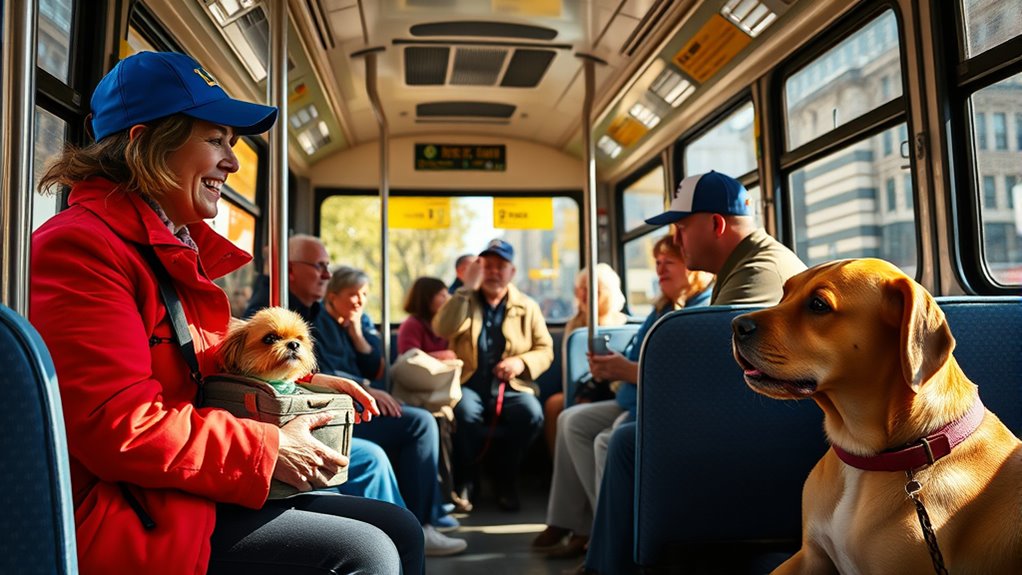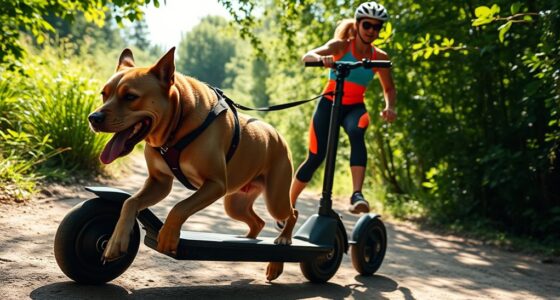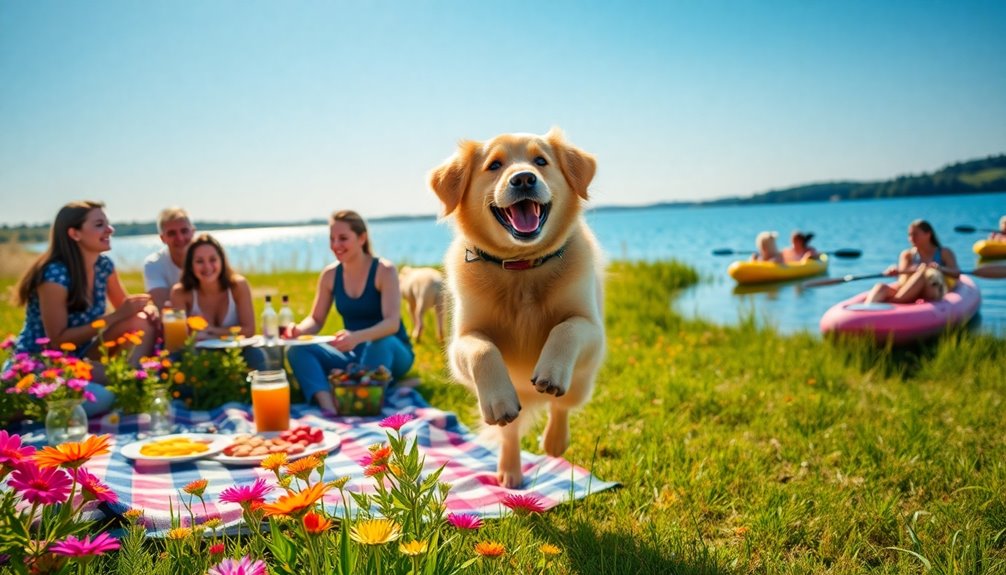When traveling on public transport with your dog, make certain you’re aware of and follow local rules and etiquette. Keep your dog in a well-ventilated, secure crate or use a harness to prevent disruption. Always clean up after your pet and avoid blocking pathways or seats. Be considerate of fellow passengers by keeping your dog calm and quiet. Proper preparation and awareness help make the journey smoother—continue on to discover key tips for respectful, safe travel with your dog.
Key Takeaways
- Check transit provider’s pet policies, including size limits and required accessories or documentation.
- Keep dogs in secure, well-ventilated crates or harnesses during travel for safety.
- Use a leash and maintain control; avoid letting dogs stick their heads out of windows.
- Be courteous to other passengers by managing noise, odors, and behavior.
- Clean up after your dog and dispose of waste properly to ensure a respectful environment.

Traveling on public transport with dogs can be convenient and stress-free if you plan ahead. One of the most important aspects of a smooth journey is ensuring your pet’s safety throughout the trip. Before you leave, invest in reliable travel accessories that help keep your dog secure and comfortable. A well-fitted harness or a sturdy crate can prevent your dog from moving around excessively, which minimizes the risk of injury or causing disruptions. Using a travel crate not only keeps your pet safe but also complies with many transit regulations. Additionally, consider bringing a collapsible water bowl and a small supply of water to keep your dog hydrated, especially during longer rides. These accessories are lightweight, portable, and make it easy to attend to your pet’s needs without hassle.
Ensure your dog’s safety with a harness, crate, and hydration supplies for a stress-free public transport journey.
When selecting travel accessories, focus on durability and safety features. Look for harnesses with secure buckles and non-slip grips, and crates with ventilation and secure latches. These details help prevent accidents and ensure your dog remains comfortable. Remember to check the transportation provider’s specific rules about pet travel, as some may have restrictions on the type or size of accessories allowed. Having the right gear ready before departure can save you time and reduce stress during boarding or transfer points.
Pet safety also involves making sure your dog is familiar with their travel accessories before the journey. Acclimate your pet gradually by letting them explore their harness or crate at home. This helps reduce anxiety and ensures they’re comfortable during transit. Bringing familiar items like their favorite blanket or toy inside the crate can also provide reassurance. Keep your dog’s identification tags and any required documentation handy, in case you need to show proof of vaccination or ownership.
During the trip, keep your pet’s safety a priority by remaining attentive to their behavior. Avoid letting your dog stick their head out of windows or roam freely in crowded spaces, as this can lead to injuries or unexpected escapes. Maintain a calm demeanor yourself, as animals often pick up on their owner’s mood. If your dog becomes anxious or upset, speak softly and offer treats or comfort to help them feel secure. Regularly check on your pet if possible, to ensure they’re comfortable and safe throughout the journey.
Furthermore, understanding the importance of color accuracy in your pet’s travel gear can help you select the most visible and safe accessories, especially in low-light conditions.
Frequently Asked Questions
Are There Specific Breed Restrictions for Dogs on Public Transport?
Breed restrictions and limitations vary by transit authority, so you should check their policies before traveling with your dog. Some services ban certain breeds considered aggressive or dangerous, like pit bulls or rottweilers. Usually, these breed limitations are in place for safety reasons. Always verify specific rules in advance to guarantee your dog’s breed isn’t restricted, and follow guidelines to ensure smooth, hassle-free travel for both you and your pet.
How Should I Handle Noisy or Anxious Dogs During Transit?
You should use dog calming techniques like gentle petting, soothing voice, or treats to ease your dog’s anxiety during transit. Noise reduction strategies, such as placing a blanket over the carrier or using a calming vest, can also help minimize noise and stress. Stay calm yourself, as your demeanor influences your dog’s behavior. Keep your dog secure and comfortable, ensuring a smoother, less stressful journey for both of you.
Can I Bring Multiple Dogs on a Single Journey?
You can bring multiple dogs on a single journey, but remember, “Don’t put all your eggs in one basket.” Make sure each dog wears a secure dog harness and has proper pet identification. Check your transit provider’s policies beforehand, as limits may vary. Keeping dogs calm and comfortable helps everyone stay safe and happy. Bringing multiple dogs is manageable with preparation, patience, and the right gear.
Are There Time Restrictions for Traveling With Dogs?
You should check specific pet carrier regulations and vaccination requirements, as some transport services impose time restrictions for traveling with dogs. Typically, you can’t travel with your dog immediately after vaccinations or during quarantine periods. Make sure your dog’s vaccinations are up to date and use an approved carrier. Planning ahead guarantees you meet all rules and avoid issues, so always verify transport policies before your journey.
What Are the Costs Associated With Bringing a Dog on Public Transport?
Think of bringing your dog on public transport as opening a wallet’s treasure chest—you’ll often face ticket pricing and pet deposits. Many transit systems charge a small fee or require a special pet ticket, while some may ask for a refundable deposit. These costs vary based on the city and transport type, so it’s prudent to verify beforehand. Remember, investing in your pup’s ride guarantees smooth travels for both of you.
Conclusion
Traveling with your dog on public transport is like guiding a tiny star through a busy night sky—bright, confident, and considerate. By following the rules and practicing good etiquette, you create a smooth journey for everyone involved. Your pup’s wagging tail becomes a cheerful flag of harmony amidst the hustle. Together, you turn a simple trip into a shared adventure, making every ride a peaceful voyage through the bustling universe of city life.










